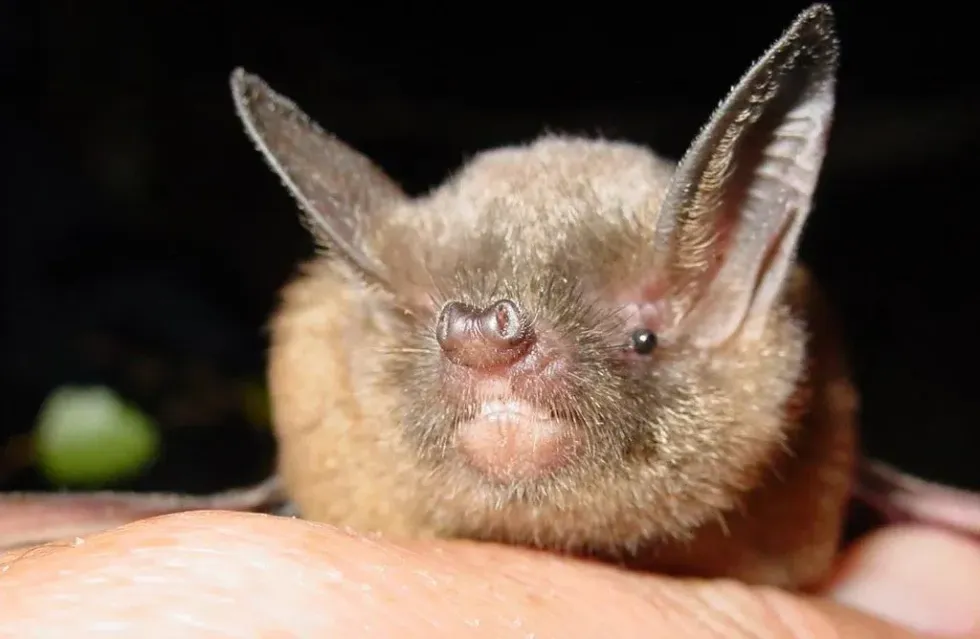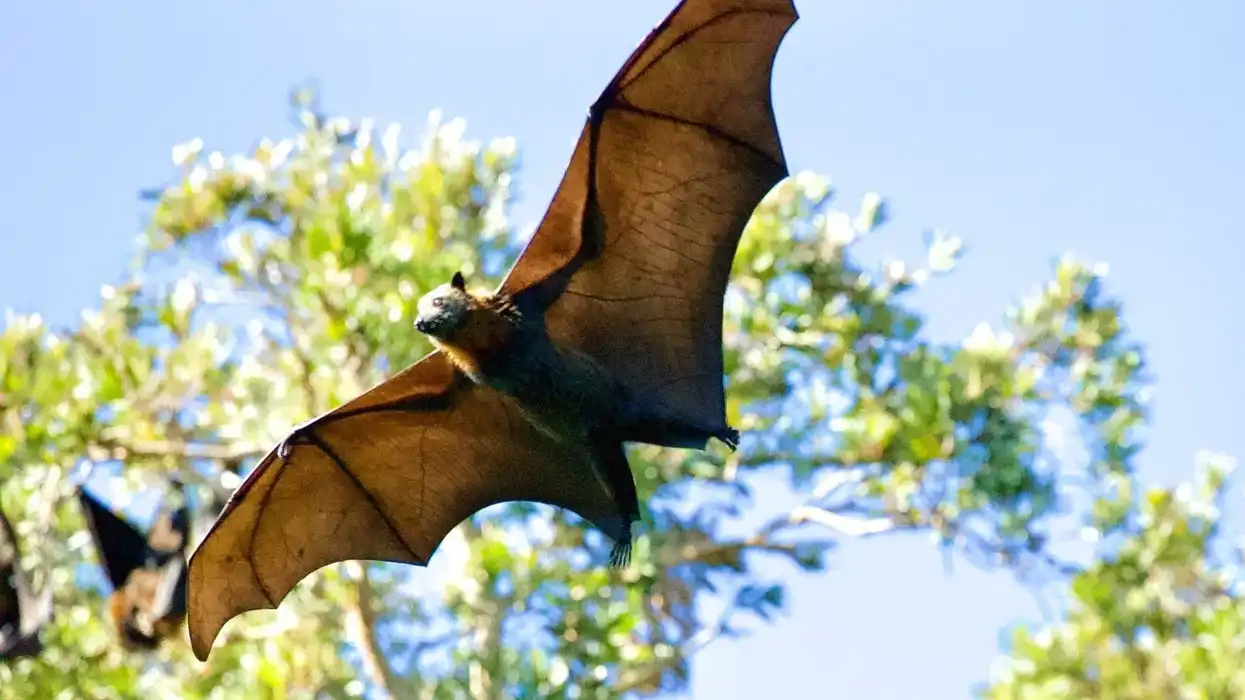New Zealand lesser short-tailed bats (Mystacina tuberculata) are a species of bat that is endemic to the islands of New Zealand. A once abundant resident of these islands, its population is slowly decreasing due to the removal of old trees, which are its primary source of roosting, and over predation by large rats and stoats.
This bat species can be identified by its thick, brownish-gray fur and short, thin tail after which it is named. It is a nocturnal hunter, foraging among the forest floor for insects, fruits, and nectar during the night and sleeping during the day.
It spends little time among the trees, only roosting in tree hollows. Otherwise, it spends most of its time on the ground. This species is listed as a species of high conservation priority by the New Zealand Department of Conservation, due to its falling numbers.
To learn more about this land-loving bat, read on! For more relatable content, check out these vampire bat facts and red bat facts for kids.
New Zealand Lesser Short-Tailed Bat Interesting Facts
What type of animal is a New Zealand lesser short-tailed bat?
The New Zealand short-tailed bat (Mystacina tuberculata) is a species of bat that is found in New Zealand.
What class of animal does a New Zealand lesser short-tailed bat belong to?
The New Zealand short-tailed bat (Mystacina tuberculata) belongs to the class Mammalia.
How many New Zealand lesser short-tailed bats are there in the world?
The current known population of these short-tailed bats amounts to around 30,000-50,000 individuals, a shockingly low number compared to its once abundant population on the islands.
Where does a New Zealand lesser short-tailed bat live?
It is an endemic species to New Zealand and can be found inhabiting the central North Island, Little Barrier Island, Codfish Island, and several small islands off Stewart Island.
What is a New Zealand lesser short-tailed bat's habitat?
This species is mostly found in temperate forests scattered across the North Island, Little Barrier Island, South Island, Codfish Island, and Stewart Island, and can be found roosting in large hollow trees and branches. They are also found in caves and in deep leaf litter, being terrestrial in nature as well.
Who do New Zealand lesser short-tailed bats live with?
This bat species can either be found living alone or in communal roosts. They can be found in hollow trees, forests, abandoned structures, and caves. As they are highly terrestrial in nature, they can also be found wandering along the forest floor, with their wings tucked up under them as legs.
How long does a New Zealand lesser short-tailed bat live?
Though the exact maximum age of these short-tailed bats is unknown, it is speculated that they can live for up to 30 years of age.
How do they reproduce?
These short-tailed bats engage in lek breeding between February and May, where a large number of males gather to sing or call in order to win the favor of female bats.
After the female bat chooses a mate, they engage in mating after which the fertilized embryo enters a state of delayed implantation throughout the winter, with the young bat being born in the summer.
These baby bats develop teeth by three weeks of age, are fully covered in fur by four, and are ready to leave the nest at just a few weeks old!
They are considered fully grown by the time they become three months old.
What is their conservation status?
The New Zealand short-tailed bat (Mystacina tuberculata) is currently listed as a Vulnerable species under the IUCN Red List. This is due to forest clearing of old hollow trees, a primary source of shelter for these bats as well as severe predation by large rats, cats, and stoats, leading to a sharp decline in their numbers.
Conservation efforts for this bats species such as protecting the habitat are being taken by the New Zealand Department of Conservation.
New Zealand Lesser Short-Tailed Bat Fun Facts
What do New Zealand lesser short-tailed bats look like?
The New Zealand short-tailed bat (Mystacina tuberculata) looks similar to other bat species, with its small furry body and large ears. Its thick fur can range from mousy brown to gray in color, with its wings being almost as wide as its body height.
This bat has small, sharp teeth and a short, thin tail after which it is named.
It can tuck its long wings under its body when not in use, and they act as extra legs to help them traverse the forest floor.
This is possible due to the presence of extra-thick membrane present in the wings. They have unique thumbs with a large claw with small extended talon, a feature that is not found in any other bat species.
* Please note that this is an image of a short-tailed bat. If you have an image of a New Zealand less short-tailed bat please let us know at hello@kidadl.com.
How cute are they?
With their small furry bodies and beady black eyes, these bats are quite cute in appearance.
How do they communicate?
New Zealand short-tailed bats communicate using echolocation. As they hunt at night when visibility is low, they give off shrill screeches. When these screeches come into contact with prey, they bounce back towards them, helping the bats to determine the prey's location. During the mating season, male bats give off chemical scents that are reciprocated by the females.
How big is a New Zealand lesser short-tailed bat?
The New Zealand short-tailed bat measures around 2.4-2.8 in (6-7 cm) on average.
How fast can a New Zealand lesser short-tailed bat fly?
These short-tailed bats have been observed to fly at an average speed of 37.3 mph (60 kph). Despite this, they are mostly terrestrial bats, spending most of their time foraging on the forest floor instead of staying in trees. While all bats fly, their nature and ability of flying varies from species to species.
How much does a New Zealand lesser short-tailed bat weigh?
These bats weigh between a range of 0.4-0.8 oz (10-22 g).
What are the male and female names of the species?
There are no specific names for either sex of this species. They are simply called male or female bats.
What would you call a baby New Zealand lesser short-tailed bat?
Baby New Zealand short-tailed bats are called pups.
What do they eat?
New Zealand short-tailed bats are omnivorous in nature and forage among the forest floor and leaf litter to find their food. They will usually eat whatever they can find, ranging from insects like beetles, crickets, flies, and moths to various fruit, nectar, blossoms, and pollen.
They are not picky when it comes to food, and are willing to travel long distances every night in search of food.
Are they dangerous?
No, this bat species is not dangerous unless they bite. They will not directly attack humans, often swooping close to catch any prey lurking nearby, but will not bite unless they feel threatened or are provoked. However, their bite can transmit rabies, a deadly disease that can prove fatal if not caught and treated in time.
Would they make a good pet?
No, keeping short-tailed bats of any species as pets is ill-advised. Bats can spread diseases such as rabies through their bite that can prove deadly to humans if not caught in time.
They are also much more suited to their natural habitats and cannot be tamed easily. It is better to observe these creatures in the wild and not approach them.
Did you know...
The lesser New Zealand short-tailed bat species is the only mammal that is endemic to New Zealand, its natural habitat.
New Zealand short-tailed bats can travel almost 6.2 mi (10 km) per day in order to forage for food! They achieve this mostly by flying.
They are a unique bat species and no close relative has been found. They are the only member of the family Mystacinidae. It is assumed that they are an ancient species.
This bat often engages in a symbiotic relationship with the New Zealand bat fly, of which it is the only host.
There are three subspecies of these bats, named the northern lesser short-tailed bat, the central lesser short-tailed bat, and the southern lesser short-tailed bat. These are named after their respective habitats, being found in the North Island, the Central Plateau, and South Island respectively.
They are the most terrestrial species of bats and are mostly seen foraging on the ground, They have a special, leathery membrane in their wings that helps them to roll them up under their bodies to act as forelegs, making it easier to move along the forest floors.
They can also sometimes be seen roosting in deep leaf litter instead of in tree hollows or upside down inside caves and abandoned structures.
Can New Zealand lesser short-tailed bats fly?
Yes, despite being mostly terrestrial birds, New Zealand short-tailed bats can fly at quite high speeds. They are known to travel almost 6.2 miles (10 km) per day in order to forage for food and achieve this by flying with their long wings.
Are New Zealand lesser short-tailed bats endangered?
New Zealand short-tailed bats are not endangered yet, though they are currently in the Vulnerable category, moving slowly towards this stage.
This rapid decline from being a commonly seen species to Vulnerable has occurred due to deforestation leading to loss of habitat for these bats, as well as predation by large rodents such as rats and stoats.
They also have a very low birth rate, with only one pup being born per female each season, and the females do not participate in breeding every year.
This has led to this species being listed as a species of high conservation priority by the New Zealand Department of Conservation.
Here at Kidadl, we have carefully created lots of interesting family-friendly animal facts for everyone to discover! Learn more about some other mammals from our greater mouse-eared bat fun facts and Mexican free-tailed bat interesting facts pages.
You can even occupy yourself at home by coloring in one of our free printable tree bat coloring pages.









